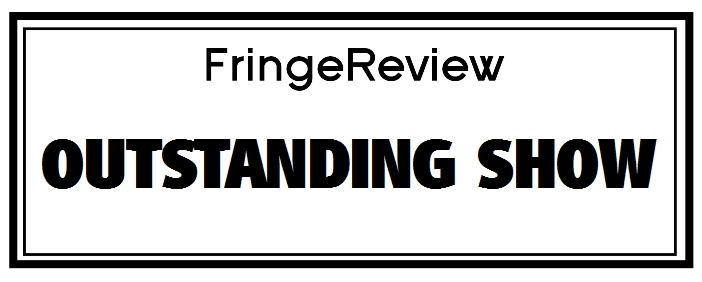Fringe Online 2020
Amadeus
National Theatre, London LiveAtHome

Genre: Biographical Drama, Costume, Drama, Historical, Live Music, Mainstream Theatre, Opera and Operatic Theatre, Theatre
Venue: National Theatre, Oliver
Festival: Fringe Online, FringeReview UK
Low Down
This 2016-2017 revival of Amadeus at the National where it premiered in 1979 is directed by Michael Longhurst with design by Chloe Lamford and production decisions by the dramatist up to his death in June 2016. Imogen Knight’s choreography is everywhere in evidence, Jon Clark’s lighting too. Paul Arditti’s sound design is worked in to a live set of performances.
Southbank Sinfonia take centre-stage and actions, playing not only Mozart but discordant tune-ups and other musics arranged and directed by Simon Slater. The fortepiano’s played by Matthew Scott.
The seasoned NT Broadcast team ensured this was one of the most sweeping and consummate instances of camerawork and lighting direction as well as – crucially – sound. This February 2017 performance captures the production at its peak.
Head of broadcast Emma Keith, Directed for screen by Tim van Someren, Technical Producer Christopher C Bretnall, Lighting Bernie Davis, Sound Supervisor Conrad Fletcher, Script Supervisor Laura Vallis, Camera Supervisor Rob Sargent, Till July 23rd.
Review
In this last screening of NT LiveAtHome, we return to another of the original NT Live productions. Like the last two weeks it’s also from 2016.
Michael Longhurst’s revival of Amadeus at the National where it premiered in 1979 was long-anticipated, even by the late Peter Shaffer himself who up to his death in June 2016 was reported to have been delighted with decisions on cast, design by Chloe Lamford and production.
It’s not surprising. Even on paper the decisions are mildy stupefying. The Southbank Sinfonia take centre-stage and actions, playing not only Mozart but discordant tune-ups and other musics arranged and directed by Simon Slater. We get excerpts from the greatest operas, but Slater’s funky take on the ‘little’ G minor Symphony 25 opening is a devilish quirk Mozart one feels would have delighted in. Slater’s full of such gusts. The Sinfonia not only play, but interact with stagehands, act miniature scenarios (cat-walking off the stage twirling a violin), refuse to play Salieri’s own opera and connect with singers often sinking and rising on the drum as Fleur de Bray’s rich coloratura also nails the dotted rhythms as Queen of the Night, swirled around on a dais. The music’s brought literally alive in a quaver of black crotchets.
Lamford’s prolegemenas are in black but a menacing gallows-like prosc-arch promises and delivers more including Dresden palace interiors and a sudden riot of Rococo colours on acid, like the confectionary Salieri has a sweet tooth for (surely one of Shaffer’s hidden jokes for such a shark).
Far from seeming out of place, Adam Gillen’s Young Ones-style shrilling brat with his technicolour frock-coats seems almost more attuned than Salieri to his milieu, though that’s deceptive. Someone said ‘an 18th Keith Flint’ and that’s as apt. Gillen astonishes in his child-like talk, a hyperbolic gesturing whether potty-mouthed or indeed eloquent as in the great setting-froth of his credo (not mass Credo, we get a Kyrie, but aesthetic) of four divergent characters expressing simultaneously different thoughts. Gillen’s speech rhythms slightly guy the weight of this just an inflection more than perhaps meant, though he’s consummately all of a piece.
We know of course this creed ends in the famous Cosi fan tutte quintet, and the hyper-active Mozart periodically recognizes as here the different psychologies of those he confronts. It’s not entirely clear why he can’t thus tailor himself to others – Gillen reads this as a man compelled by the speed of his own impatient velocity – something of Mozart’s original, here on acid. Shaffer’s text allowed for this though it becomes a party-turn and though Gillen’s jerky shudderings in his last scene is harrowing, it disconnects us just a tad too much.
Gillen’s greatest contortion is one of the production’s – and play’s – coups: Salieri’s march of welcome transposed into Count Alma Viva’s predatory aria where Gillen crouches over the piano still playing like the violinists of the day who strummed their instruments upside-down.
It’s naturally the corresponding gravity this production looks to: Lucian Msamati’s supremely crafted lead sets off the quicksilver of his rival to an unprecedented extent. Each word engraves the air, each pact with God (the ensemble behind inclining) each illumined illusory benediction priming Salieri for his great break and war with God: Yeats’s ‘Now his wars on God begin/at stroke of midnight God shall win’ seem apposite here. Msamati though shows what a courtier he is, faux-chivalry sliding sometimes to smothered pique, anger or real compassion when he registers his own loss, and supremely at the opening and close where his thrillingly damned majesty calls forth the smoky darkness and spectacle of the Olivier
It would have been good to hear his catalogue of successes (we now know his operas better, there are recordings) and that brief quip about Mozart’s concertos being ignored by Vienna was an important underscoring of the plot. But with the production clocking three hours snips are forgivable.
There’s some fine caricature with warmth from Karla Crome’s Constanza, warm Essex girl pitched beyond endurance, prepared at one point to trade sex with Salieri and never hiding her contempt, but pragmatic enough to know when to quit Mozart, big-hearted enough when to return.
Hugh Sachs’ venomous count Rosenberg, Tom Edden’s twittish Joseph II, Alexandra Mathie’s professionally outraged Count von Strack and Geoffrey Beevers’ stiffly sympathetic Baron Van Swieten perform admirably, as do the singers headed by the rapturously sexy de Bray and mezzo Wendy Dawn Thompson, Eamonn Mulhall’s tenor and Peter Willcock’s bass-baritone. Andrewx MaccBean’s a much put-upon kappelmeister, Everal A Walsh a flourishing major-domo. These are to a greater or lesser extent cameo turns but as vividly-raised in profile as their costumes.
There’s energetic ensemble work throughout, from Nicholas Gerrard-Martin, Matthew Hargreaves (a bass-baritone), Michael Lye, Robyn Allegra Parton (soprano) and Eleanor Sutton.
The sheer swerve and movement of this production is a wonder, even on this stage – swept of its vibrant gaudy to stark boards in a moment. Imogen Knight’s choreography is everywhere in evidence, and at one moment has to parade an orchestra of performing musicians in an outer troop round the acting core. Jon Clark’s lighting is as you’d expect blazing noon or sulphurous midnight. Nothing stills itself except for Salieri, and Paul Arditti’s sound design is worked in to a live set of performances where singers nudge with speakers and the orchestra stalks around almost on point.
This isn’t naturally the real Mozart, and the less than villainous Salieri was a far finer composer than the patron saint of mediocrities presented here. His reputation has almost soared since 1979. Cecilia Bartoli’s famous mezzo rescue mission has been followed up and he’s getting quite ubiquitous, certainly in concert arias. His energetic overtures too are readily available. But the axis of genius versus great talent remains, and though psychologically the play skates to its premise, the creation of Salieri, and Msamati’s recreation of it, is a triumph. Here in the agon of his perceived mediocrity, an artist of taste has ears singularly pricked to his lack and another’s genius. Salieri reflects on the bitter blind justice of what God or the gods love, loath and tease with. Artist envy… is us. It’s a unique expression of the artistic and human predicament, which is why it’ll always bear revival
We need the National to return at this pitch, and this power. Please consider donating.

































